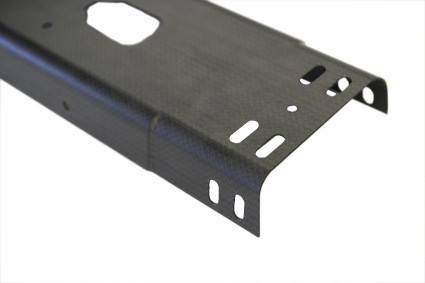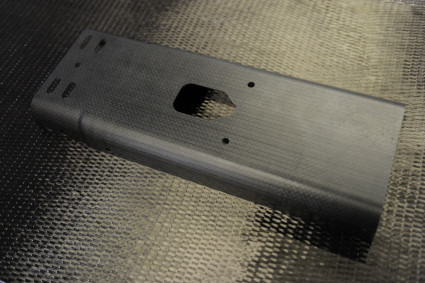SHANGHAI--(BUSINESS WIRE)--Through the development of its new polyurethane matrix resin, Loctite MAX 3, Henkel has taken a further important step toward fully automated series production of composite components for the automotive industry. In collaboration with KraussMaffei, Henkel – the world market leader for adhesives, sealants and surface treatment technologies – has developed a process for the manufacture of components based on glass or carbon fiber and using high-pressure RTM (HP-RTM) technology that creates a surface quality good enough for automobile exteriors. Using a model of the light, high-strength carbon fiber roof segment of the Roding Roadster R1, this innovative production process is due to be presented at “K,” the world’s most important trade fair for the plastics and rubber industries, due to place from October 16 to 23 in Düsseldorf.
Lightweight construction technologies are gaining ever more importance in the automotive industry because they help reduce the weight of the overall vehicle, something that is becoming a necessity in the face of strict exhaust requirements and as an avenue for decreasing both fuel consumption and CO2 emissions. Composite materials based on carbon or glass fibers combine lightness in weight with enormous strength, thus offering outstanding properties in relation to safety and crash behavior. Until now, there have been certain limitations in the use of lightweight components. They are restricted in the degree to which they can meet the requirements of the automotive industry with respect to cycle times and level of automation. In particular, composites have been very rarely used for the external components of production vehicles, as the requisite post-treatment of the surface for subsequent painting has been too time-consuming and had to be performed manually. KraussMaffei, a leading manufacturer of machinery for plastics manufacturing and processing, together with Henkel as a specialist for matrix resin, and Rühl Puromer GmbH, a globally active independent polyurethane systems house, has succeeded in producing – in a fully automated process – composite components with a surface quality suitable for immediate painting. This has become possible thanks to the development of Loctite MAX 3, a three-component polyurethane-based matrix resin system from Henkel that contains not only the resin and hardener but also a high-performance internal release agent matched to a self-releasing polyurethane lacquer from Rühl Puromer GmbH. Thus, Henkel – together with Dieffenbacher, Zoltek, Chomarat, Rühl Puromer, Alpex, Mühlmeier and Roding Automotive – has become part of KraussMaffei’s network of specialist partners contributing to the establishment of a mature, reliable production chain extending from the fibers and matrix materials through to the finished component.
Increased temperature resistance directly after demolding
This polyurethane-based matrix resin technology from Henkel is characterized by significantly faster curing compared to the epoxy resins usually used for the RTM (resin transfer molding) process. Due to its low viscosity, the resin penetrates the fiber material more easily and with less disruption, giving rise to shorter injection times and thus short cycle times in series production. The outstanding toughness of Loctite MAX 3 also facilitates achievement of an optimized component structure. Henkel has likewise improved the temperature resistance of the PUR resin, taking Loctite MAX 3 to a level comparable with that of epoxy resins in relation to this particular property. This high temperature resistance means that the fiber-reinforced composites can be demolded more quickly. With the internal release agent ensuring easy detachment of the component from its mold, the resultant surface is of sufficiently high quality to allow immediate painting and bonding. This accelerates the production process and enables manufacture of external and visible components of outstanding surface quality.
Flexible inclusion within an integrated concept
For the automotive industry particularly, integration within an overall package is essential for this technology to be regarded as application ready. Consequently, Henkel offers individually formulated adhesives designed to ensure the reliable process integration of the different component materials within the framework of advanced multimaterial concepts. The various elements must be ideally coordinated if the adhesives are to perform to their full potential. “With Loctite MAX 3, we now have a matrix resin system that further increases the feasibility and attractiveness of manufacturing automotive parts from composite materials,” says Frank Deutschländer, Global Market Manager Automotive at Henkel AG & Co. KGaA. “Working closely with KraussMaffei, we have optimized the properties of our resin so that both painted coatings and adhesives can be applied to the resultant composite surface without the need for any pretreatment.” With the adhesives portfolio from Henkel, this gives rise to a complete system solution enabling the manufacture and integration of composite components in automobiles.
Experts from Henkel will be available at “K 2013” from October 16 to 23, at the KraussMaffei booth in Hall 15 (Stand B27/C24/C27/D24), ready to answer questions and provide insights and information regarding the company’s product solutions for composite production.
You can find further information at www.henkel.com/automotive.
Loctite is a registered trademark of Henkel in Germany and elsewhere.
Henkel operates worldwide with leading brands and technologies in three business areas: Laundry & Home Care, Beauty Care and Adhesive Technologies. Founded in 1876, Henkel holds globally leading market positions both in the consumer and industrial businesses with well-known brands such as Persil, Schwarzkopf and Loctite. Henkel employs about 47,000 people and reported sales of 16,510 million euros and adjusted operating profit of 2,335 million euros in fiscal 2012. Henkel’s preferred shares are listed in the German stock index DAX.
Photo material is available at http://www.henkel.com/press






